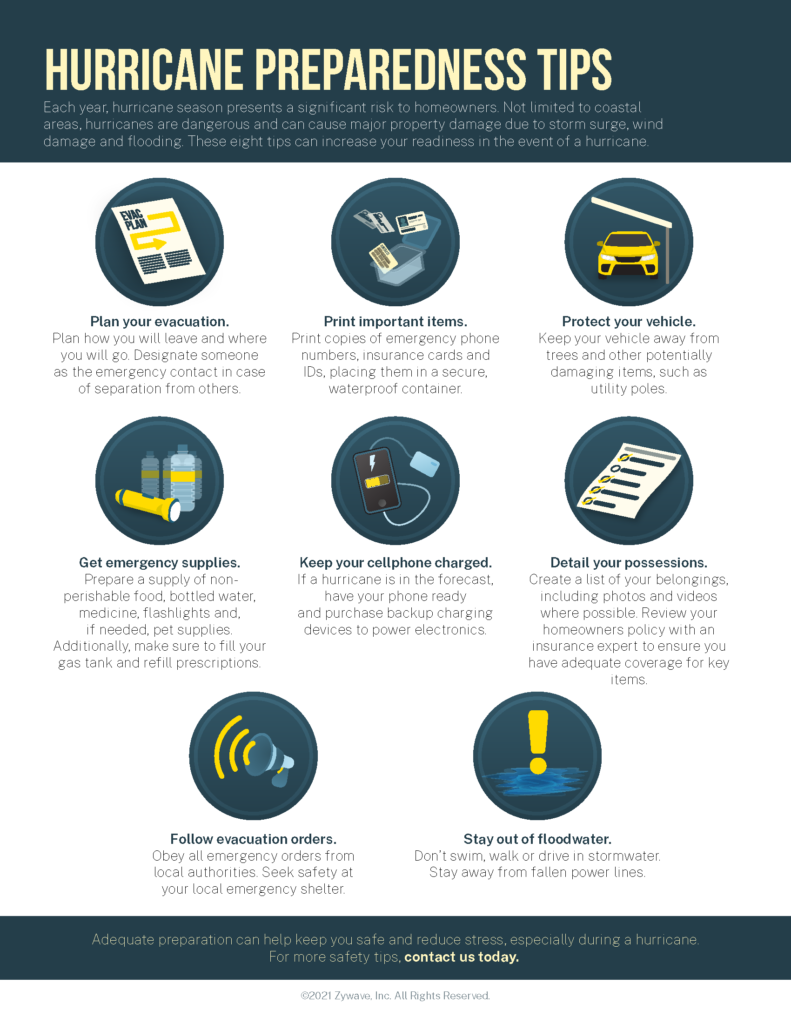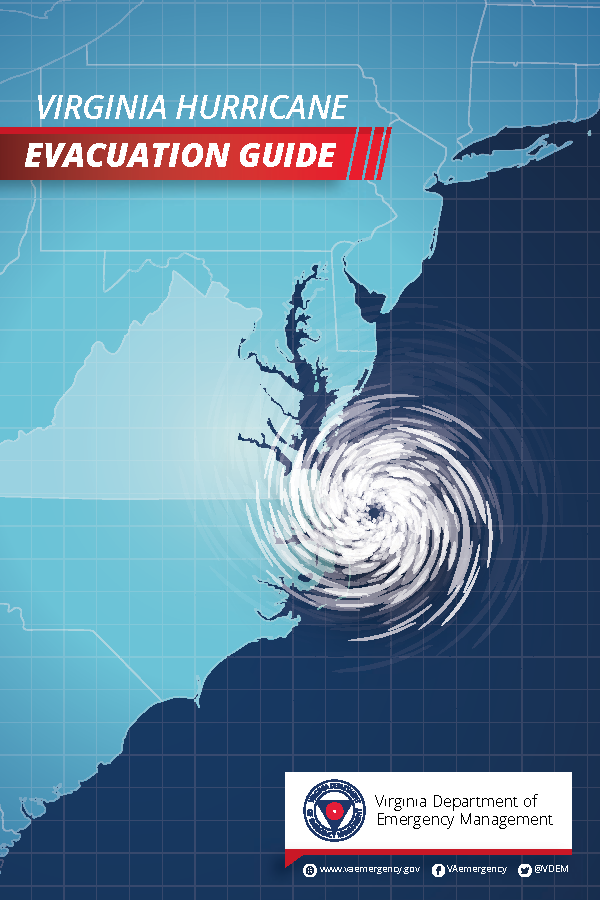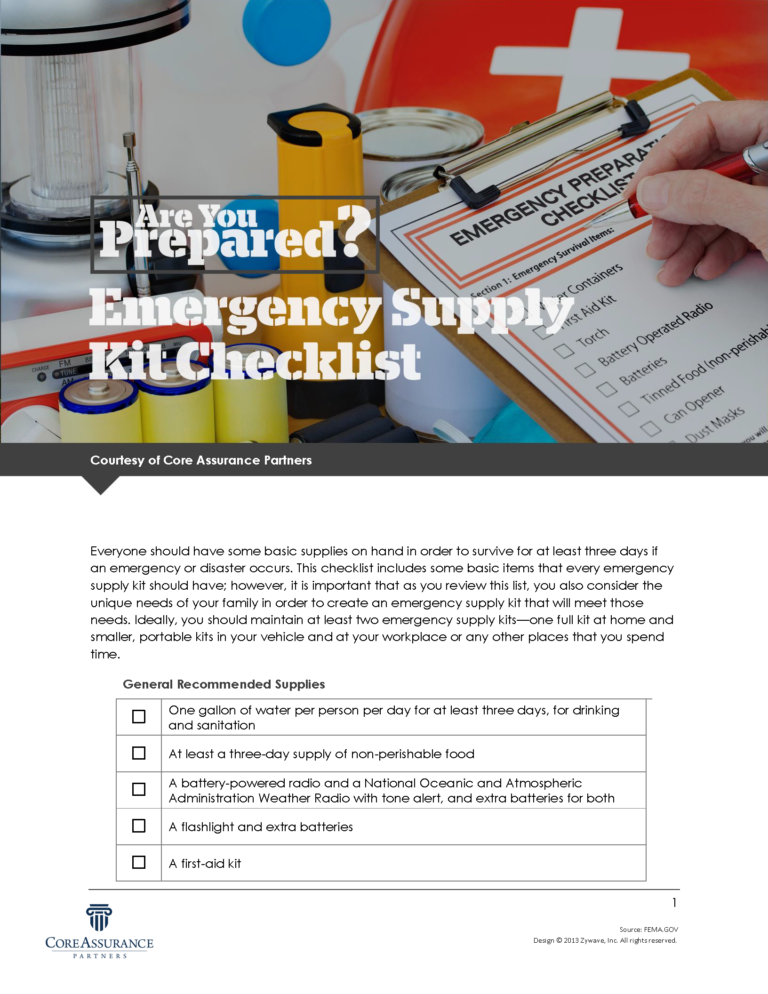
Updated: August 10, 2023
The National Oceanic and Atmospheric Administration (NOAA) issued its annual mid-season update today and increased its prediction for the ongoing 2023 Atlantic hurricane season from a “near-normal” level of activity to an “above-normal” level of activity.
NOAA forecasters have increased the likelihood of an above-normal Atlantic hurricane season to 60% (increased from the outlook issued in May, which predicted a 30% chance). The likelihood of near-normal activity has decreased to 25%, down from the 40% chances outlined in May’s outlook. This new update gives the Atlantic a 15% chance of seeing a below-normal season.
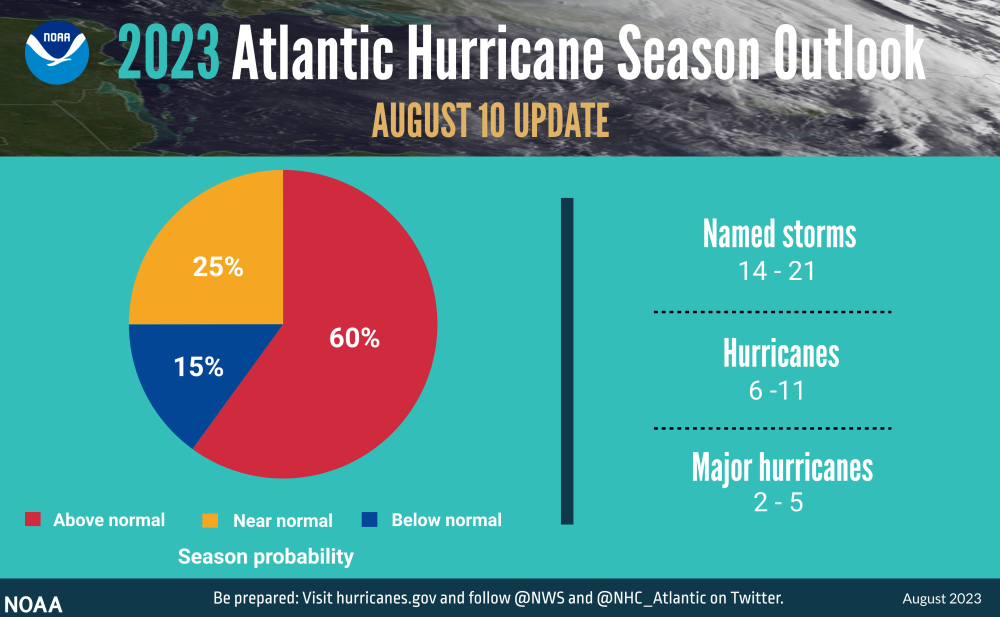
The Atlantic basin experienced an active start to the hurricane season with five storms that have already reached at least tropical storm strength, including one hurricane. An average hurricane season produces 14 named storms, of which seven become hurricanes, including three major hurricanes.

Experts urge everyone in vulnerable areas to have a well-thought-out hurricane plan and stay informed through official channels as this season progresses.
May 25, 2023
The National Oceanic and Atmospheric Administration (NOAA) found that 2022 recorded 18 separate billion-dollar weather and climate disasters in the country, representing the third-highest number of such disasters in a calendar year and totaling $165 billion in overall damages.
The 2022 Hurricane Season produced 14 named storms (winds of 39 mph or greater), of which eight became hurricanes (winds of 74 mph or greater), and two intensified to major hurricanes with winds reaching 111 mph or greater.
For 2023, forecasters at NOAA’s Climate Prediction Center predict a “near-normal” Atlantic Hurricane Season for the first time in years. NOAA’s outlook for the 2023 Atlantic Hurricane Season, which extends from June 1 to November 30, predicts a 40% chance of a near-normal season, a 30% chance of an above-normal season, and a 30% chance of a below-normal season.
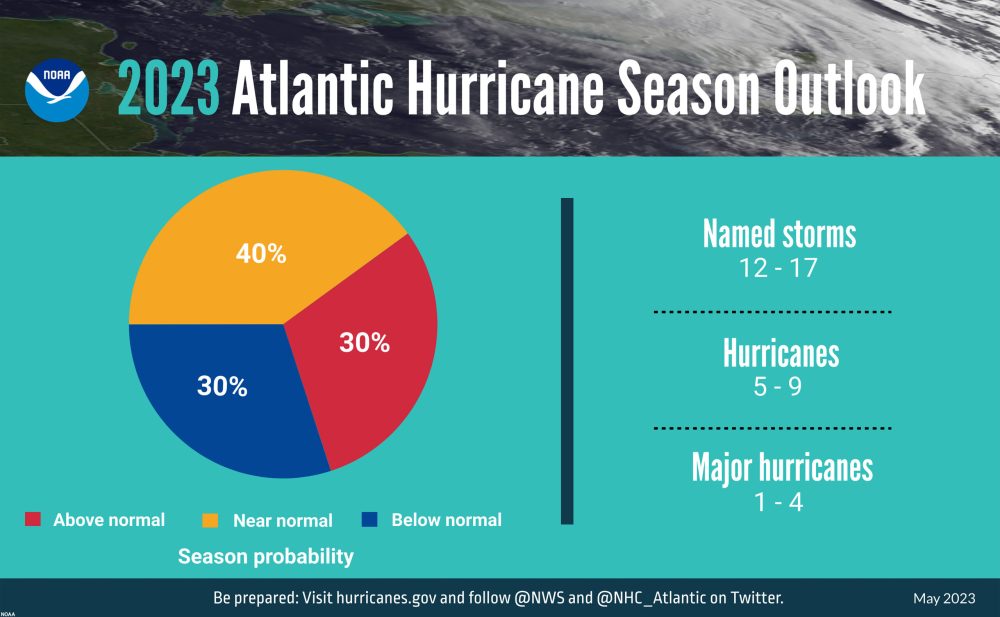
NOAA is forecasting a range of 12 to 17 total named storms. Of those, 5 to 9 could become hurricanes, including 1 to 4 major hurricanes (category 3, 4 or 5).

The Atlantic Hurricane Season is expected to be less active than in recent years due to competing factors — some that suppress storm development and some that fuel it — driving this year’s overall forecast for a near-normal season:
- after three hurricane seasons with La Nina present, scientists predict a high potential for El Nino to develop this summer, which can suppress Atlantic hurricane activity
- favorable conditions local to the tropical Atlantic Basin
- warmer-than-normal sea surface temperatures in the tropical Atlantic Ocean and Caribbean Sea, which creates more energy to fuel storm development
- an above-normal west African monsoon, which produces African easterly waves and seeds some of the stronger and longer-lived Atlantic storms
Although predictions for hurricane season vary each year, preparation and planning are essential to minimizing your exposure to risk when considering the impact of a catastrophic event. Please visit this Resource Center for up-to-date information and tools throughout hurricane season.
NOAA will issue its mid-season update in August, and we will share it here accordingly.
Updated: August 10, 2023
The National Oceanic and Atmospheric Administration (NOAA) issued its annual mid-season update today and increased its prediction for the ongoing 2023 Atlantic hurricane season from a “near-normal” level of activity to an “above-normal” level of activity.
NOAA forecasters have increased the likelihood of an above-normal Atlantic hurricane season to 60% (increased from the outlook issued in May, which predicted a 30% chance). The likelihood of near-normal activity has decreased to 25%, down from the 40% chances outlined in May’s outlook. This new update gives the Atlantic a 15% chance of seeing a below-normal season.
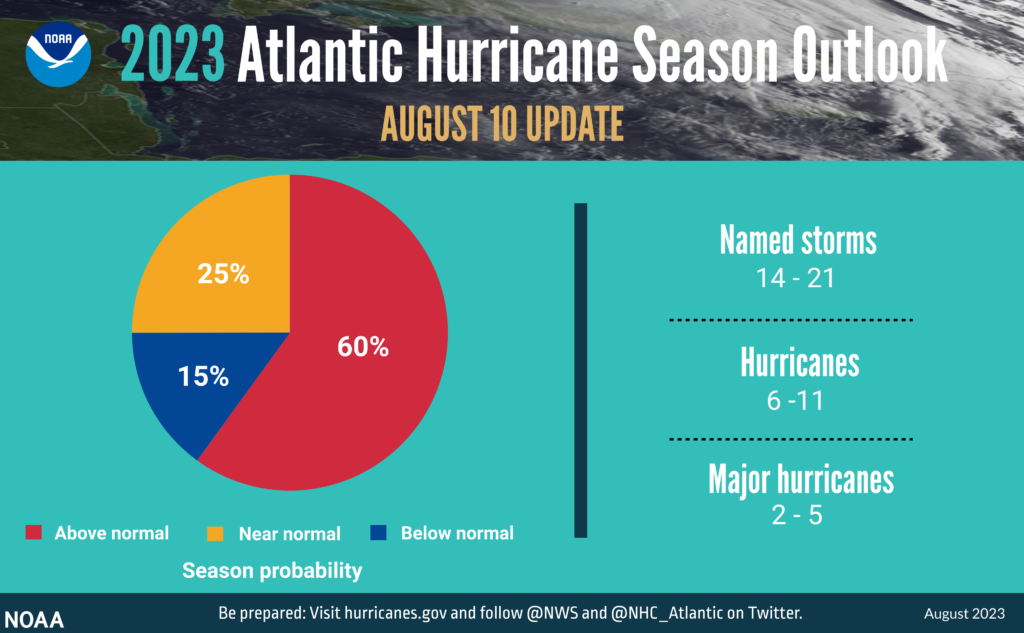
The Atlantic basin experienced an active start to the hurricane season with five storms that have already reached at least tropical storm strength, including one hurricane. An average hurricane season produces 14 named storms, of which seven become hurricanes, including three major hurricanes.

Forecasters believe that current ocean and atmospheric conditions, such as record-warm Atlantic sea surface temperatures, are likely to counterbalance the usually limiting atmospheric conditions associated with the ongoing El Nino event. (see below)
Experts urge everyone in vulnerable areas to have a well-thought-out hurricane plan and stay informed through official channels as this season progresses.
May 25, 2023
The National Oceanic and Atmospheric Administration (NOAA) found that 2022 recorded 18 separate billion-dollar weather and climate disasters in the country, representing the third-highest number of such disasters in a calendar year and totaling $165 billion in overall damages.
The 2022 Hurricane Season produced 14 named storms (winds of 39 mph or greater), of which eight became hurricanes (winds of 74 mph or greater), and two intensified to major hurricanes with winds reaching 111 mph or greater.
For 2023, forecasters at NOAA’s Climate Prediction Center predict a “near-normal” Atlantic Hurricane Season for the first time in years. NOAA’s outlook for the 2023 Atlantic Hurricane Season, which extends from June 1 to November 30, predicts a 40% chance of a near-normal season, a 30% chance of an above-normal season, and a 30% chance of a below-normal season.
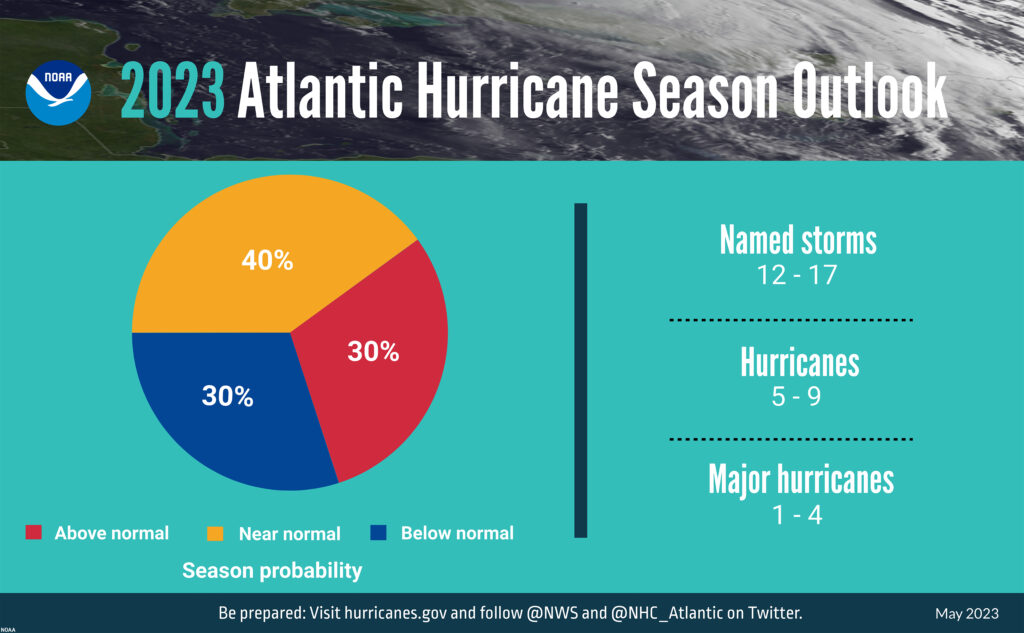
NOAA is forecasting a range of 12 to 17 total named storms. Of those, 5 to 9 could become hurricanes, including 1 to 4 major hurricanes (category 3, 4 or 5).
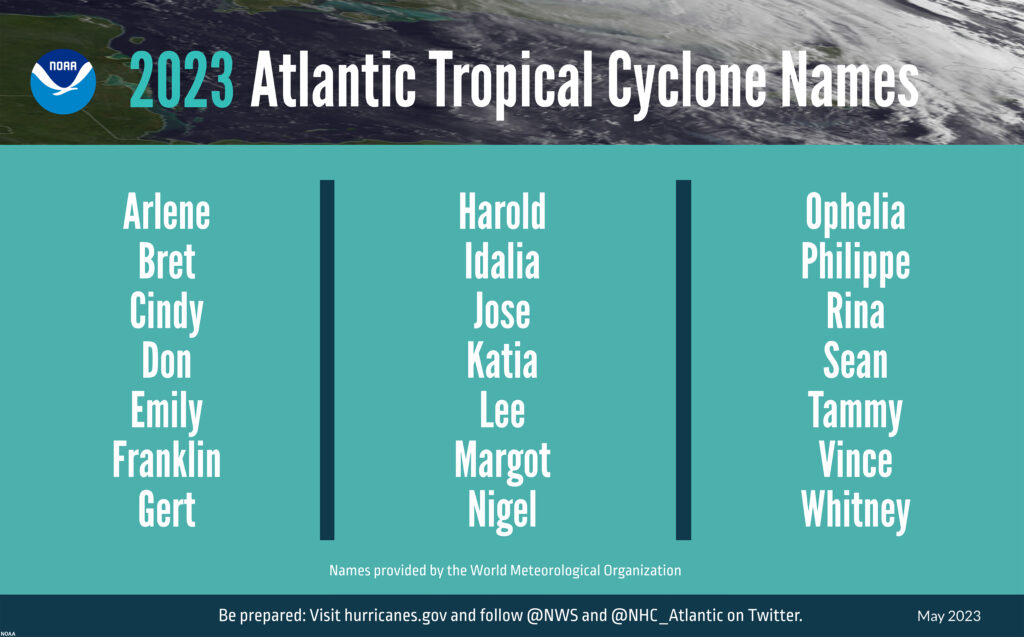
The Atlantic Hurricane Season is expected to be less active than in recent years due to competing factors — some that suppress storm development and some that fuel it — driving this year’s overall forecast for a near-normal season:
- after three hurricane seasons with La Nina present, scientists predict a high potential for El Nino to develop this summer, which can suppress Atlantic hurricane activity
- favorable conditions local to the tropical Atlantic Basin
- warmer-than-normal sea surface temperatures in the tropical Atlantic Ocean and Caribbean Sea, which creates more energy to fuel storm development
- an above-normal west African monsoon, which produces African easterly waves and seeds some of the stronger and longer-lived Atlantic storms
Although predictions for hurricane season vary each year, preparation and planning are essential to minimizing your exposure to risk when considering the impact of a catastrophic event. Please visit this Resource Center for up-to-date information and tools throughout hurricane season.
NOAA will issue its mid-season update in August, and we will share it here accordingly.
June 1, 2022
The 2021 hurricane season was the third most active on record (with 21 named storms) and marked the sixth consecutive above-normal Atlantic hurricane season, according to the National Oceanic and Atmospheric Administration (NOAA). Estimated losses exceeded $70 billion, the fourth most on record, with more than 90% caused by Hurricane Ida alone.
Forecasters at NOAA’s Climate Prediction Center predict an above-average Atlantic hurricane season for the seventh consecutive year. NOAA’s outlook for the 2022 Atlantic hurricane season, which extends from June 1 to November 30, predicts a 65% chance of an above-normal season, a 25% chance of a near-normal season, and a 10% chance of a below-normal season.

While an average season typically spawns seven hurricanes, forecasters are predicting that as many as 10 hurricanes with sustained winds of 74 mph or more could form in 2022. Of the predicted hurricanes, between three and six storms may reach Category 3, 4, or 5 with sustained winds of 111 mph or more. In addition, the NOAA is estimating that 14 to 21 named storms might develop, including tropical storms containing wind speeds of 39 mph or more.
The NOAA is attributing increased storm activity in 2022 to serval climate factors, including:
- the ongoing La Niña that is likely to persist throughout the hurricane season
- warmer-than-average sea surface temperatures in the Atlantic Ocean and the Caribbean Sea
- weaker tropical Atlantic trade winds
- an enhanced West African monsoon, which is known to contribute to strong and long-lasting hurricanes.
As hurricane season becomes longer and more intense, it’s imperative to abide by federal, state, and local guidance regarding hurricane safety. And although predictions for hurricane season vary each year, preparation and planning are essential to minimizing your exposure to risk when considering the impact of a catastrophic event.
Hurricane Preparedness
- Determine your hurricane risk
- Know what to do before, during, and after a hurricane (PDF)
- Make an emergency plan
- Build or restock your emergency supply kit (PDF)
- Learn your local evacuation routes
- Stay tuned to local wireless emergency alerts, TV, or radio for weather updates, emergency instructions, or evacuation orders
- Consider buying flood insurance
Hurricane Preparedness
- Determine your hurricane risk
- Know what to do before, during, and after a hurricane (PDF)
- Make an emergency plan
- Build or restock your emergency supply kit (PDF)
- Learn your local evacuation routes
- Stay tuned to local wireless emergency alerts, TV, or radio for weather updates, emergency instructions, or evacuation orders
- Consider buying flood insurance
Flood Insurance Information
- Homeowners insurance alone does not cover flooding
- This includes flooding as a result of storm surge
- Most flood insurance policies have a waiting period ranging from 14 to 30 days, so it is critical to make sure you are insured before you find out a storm is heading your way
- FEMA does not provide comprehensive disaster funding to repair homes that flooded but didn’t have insurance
- Even non-coastal areas can be severely impacted by flooding
- Determine your Flood Risk
- The National Flood Insurance Program aims to reduce the impact of flooding by providing affordable insurance to property owners and by encouraging communities to adopt and enforce floodplain management regulations
If you live in Coastal Virginia
- Know your hurricane evacuation zone for both your home and your workplace.
- Register with VBgov.com/VBAlert to receive emergency notifications on your mobile devices.
- Virginia Department of Emergency Management
If you live in Coastal Virginia
- Know your hurricane evacuation zone for both your home and your workplace.
- Register with VBgov.com/VBAlert to receive emergency notifications on your mobile devices.
- Virginia Department of Emergency Management
How to Report a Claim
We hope that you will never need to, but in the event you should have to report a claim, the best method is to contact your insurance carrier directly. Prompt claims reporting is critical. It is helpful to have your policy number available when reporting a claim.
- Download this Claims Checklist for Severe Weather Damage (PDF) from our carrier partners at AmWins for further guidance
We would be happy to assist you with reporting a claim. You may reach us during regular business hours by phone, (757) 965-8900, or email claims@coreassurance.com.
If outside regular business hours, please use the button to the right to submit an incident report – a member of our client service team will reach out to you as soon as possible.
How to Report a Claim
We hope that you will never need to, but in the event you should have to report a claim, the best method is to contact your insurance carrier directly. Prompt claims reporting is critical. It is helpful to have your policy number available when reporting a claim.
- Download this Claims Checklist for Severe Weather Damage (PDF) from our carrier partners at AmWins for further guidance
We would be happy to assist you with reporting a claim. You may reach us during regular business hours by phone, (757) 965-8900, or email claims@coreassurance.com.
If outside regular business hours, please use the button to the right to submit an incident report – a member of our client service team will reach out to you as soon as possible.
How CORE Can Help
We offer a full portfolio of risk management products and services to protect your home and business from flood and hurricane damage. For more information on how to protect your property and loved ones, contact one of our Private Client or Business Insurance associates today.


